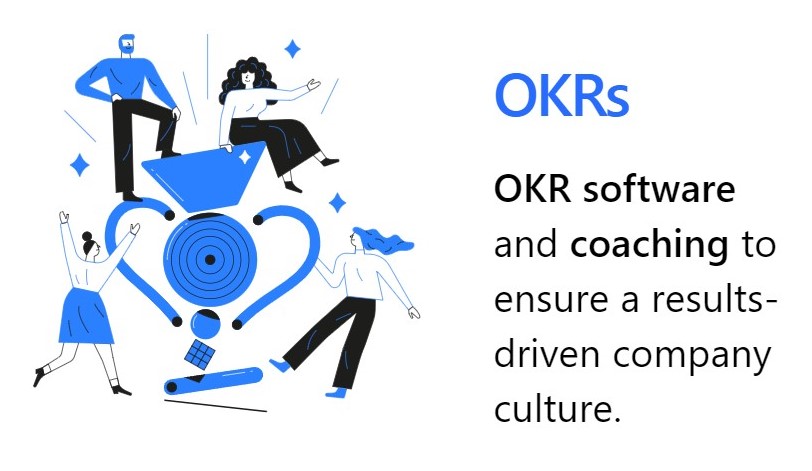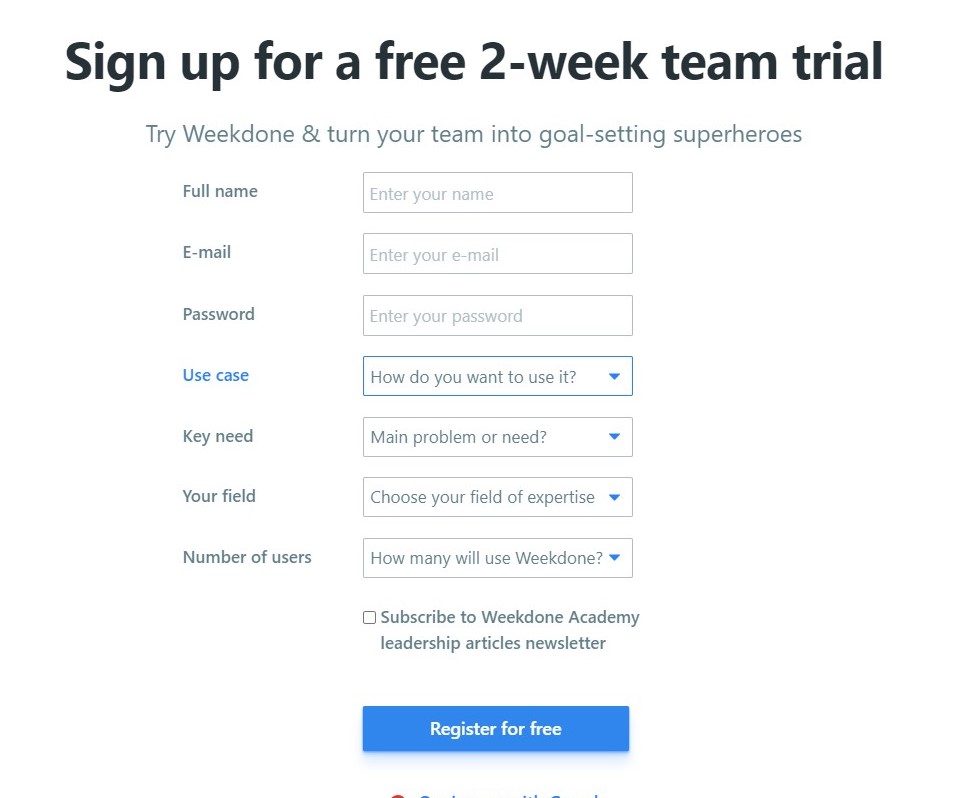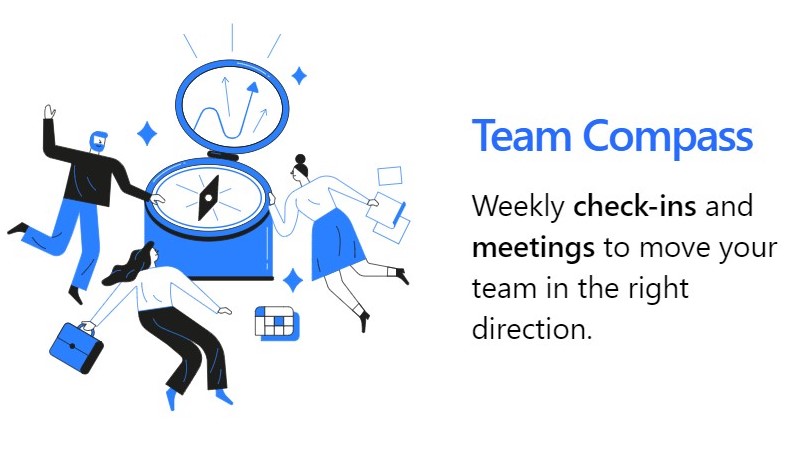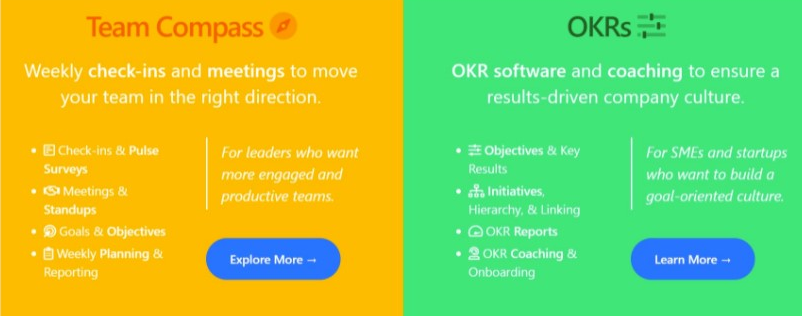Leads won’t convert if they don’t see any value in your product. Often the first step in improving conversion is by developing your product story and more clearly defining the values you offer. But what happens if your leads still see different values in the same product?
We faced this very problem at Weekdone. We had great leads coming from blogs and mini-sites, but our sales funnel was not designed for all use cases and funnels. Most B2B SaaS platforms face similar issues. With numerous feature sets and tools, people come with a variety of expectations and use cases in mind.
For us people come in with a variety of problems such as their team growing, old tools failing, and needing more alignment throughout the company. Weekdone helps solve these problems through a variety of solutions including Objectives and Key Results (OKRs), weekly reporting, 1:1s, and feedback and recognition. Through customer research we had already defined multiple use cases: organizational goal-setting and OKRs, align and organize the company, engagement and feedback, personal productivity, team product management, and progress reporting.
For our sales team if a lead came in looking for organization goal-setting and OKRs they considered a better lead as their funnel was designed for that specific use case. But our product could be used in multiple ways and many people came in interested in our whole feature set not just OKRs. This way what truly differentiated our MQLs (Marketing Qualified Leads) from our SQLs (Sales Qualified Leads) was expected product value. When you have competing values one potential solution is using psychographic segmentation.
Using Psychographic Marketing Segmentation
So, what is psychographic segmentation exactly? And, how do you use it in marketing?
Psychographic segmentation is a segmentation strategy where you break your audience apart by sets of psychological traits. These traits can include:
- Values
- Needs
- Attitudes
- Opinions
- Beliefs
- Life Style
- And so on…
Psychographic segmentation is powerful because it targets the customers based on how they feel and the issues they have. By targeting the customer based on their beliefs they will have a much stronger emotional response and see much more value in your product. One important thing to take into consideration is their problem situation, use case, and need as well.
This can be much harder to do compared to other types of segmentation, such as geographical segmentation where you may already have your data and don’t need to look any further than Google Analytics. To do powerful psychographic segmentation you need data on the needs and problem situation of your leads. This may require you to survey your leads and existing customers to collect more information.
To give you an idea of how you can implement psychographic segmentation, we thought we would share how we have used it at Weekdone. We will go over the steps and processes we went through to implement it, starting from the thinking and questions we asked down to the tools and methods we used to do it.
The scene:
Weekdone has always prided itself in being the #1 OKR goal-setting software. But Weekdone actually started out as a weekly reporting and team communication software. It still very much is that, but many of our customers today come looking for goal-setting and OKRs first and foremost, so we have built much of our sales funnel around that need.

Historically, we’ve created original content and campaigns around topics ranging from team building activities to articles of semiotics. This introduced a large variety of organic leads to our platform with needs other than “goal-setting and OKRs”.
After experiencing many lukewarm leads – our sales team realized there was a problem. They found that users interested in a weekly planning or team communication software would often struggle with the OKR product – and ultimately churn too soon.
Marketing was then left with hundreds of sign-ups each month who were amazing MQLs but had no chance of becoming an SQL. The question became what can we do with these “bad leads” who weren’t so bad at all but just not ready for OKRs.
So we asked: “Can we build a product for people looking to solve team management issues, with minimal customer support resources, and simple pricing?”
The action:
This is where the idea of psychographic segmentation came in. We decided to segment our leads based on the use case and need they came in with. Instead of simply moving them into separate email funnels we wanted to attempt a product split. This way the product could better reflect their incoming needs and values across the customer journey.
We decided to create two parallel products, one focused on companies looking to implement OKRs and the others focused on general team management issues, which we gave the working title D1, our clever take on the word “Done” and “Day 1”. We agreed to make a parallel product with some minor structural changes and simplifications.
The team:
As OKR was still the money maker we could not divert all of our resources to an experimental segmentation project. We had to do things quickly and on the fly. At the start it was me (Head of Marketing) and our CEO, who took on the bulk of the project. The product team and other marketing team members helped along the way with help as needed.
Psychographicaly segmenting customers:
Putting our idea into action, we began to psychographicaly segment our customers. We had historically collected the use case and need of our sign-ups. This was originally done as part of our Jobs to Be Done research to better understand the value people were looking for in our product.
From Registration:
We first used our home page registration form to filter out people with OKR intent. Our sales team knows that if that’s missing, they won’t convert. We used this form to filter out people into the D1 product, by moving all the people who answered anything relating to team engagement, productivity, project planning etc. as their main use case.

At first we were quite nervous that people would get put into the wrong category, but to our surprise, we had no drop in the total number of SQLs. This meant that we had managed to accurately segment based on use case and need and that we would not be disrupting the sales funnel too much.
The only problem was that we created another issue of value. As people coming in from our home page would have been exposed to messaging from our landing that did not match with the D1 product. It then became necessary to figure out how we could create a separate marketing funnel.
From our Blog:
To build a stronger marketing funnel, we created a series of landings with custom registrations that would categorize the people into the 5 experimental segments. We updated internal links on our blog posts to direct people to those landings as opposed to our general home page. We had already created custom categories for each of our blogs in wordpress, so all we needed to do was review the blog posts in each category, change the links, and set-up custom overlays.
Improving marketing segmentation:
About a month after our initial round of psychographic segmentation, we needed to better build the funnels and further develop messaging and values. At this time we started to convert some of the leads into trials and paying customers.
The team:
At this stage we had more product resources to further strengthen our product split. We also took two team members to focus solely on the product and marketing research. Through customer feedback we managed to come up with a name for the product – D1 is now Team Compass.

Segementation:
We created a split screen on our primary landing to better segment the people coming in through direct searches. The idea was that people can go to the product that best fits the values and needs they came in with.

At this stage we also narrowed down our landing pages to the best performing ones, in order to direct people through a funnel that most closely aligns with their values.
Next Steps:
At this stage there is still minimal product and front-end resources for Team Compass, so much of the effort is still marketing driven. We began further experimenting with Google ads to better target keywords and associated search intents. We followed this up with continued landing page messaging experiments and link-building.
At this point much of the team went on summer vacation, so we are just getting back into things. We see a lot of potential for Team Compass, but still have a lot of work to do before the funnel is ready to go. We also need to further develop the product and establish a measurement matrix for the Team Compass data.
Tools Used
Weekdone – for team management and keeping everyone updates
Intercom – for setting up our email funneling
Nelio A/B – added to our blog for landing experiments
OptinMonster – for on page overlays
Ahrefs – SEO analysis and new keyword planning
Google Analytics, Ads, etc. – the usual marketing set
Moving Forward
Now that we are down this path we need to work on improving email funnels and in-product set ups to more closely match with the messaging. Our biggest hurdle is now getting people converting and finding the messaging and product suite that actually addresses their problem situation and needs.
Psychographic segmentation is not a one and done process for sure. Values and needs are always changing, and it is critical to be able to adapt to the changing needs of the market.
Our new landings are now starting to get organic traffic and rank, but we now need to work on link building around these pages.
Additionally, we will do more customer research to find out what people are looking for and how Team Compass can become the “go-to” product on the market that solves the needs of managers and their teams.
